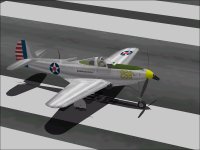This is another Airacobra that is loaded on my Development Machine.
After releasing the update (Version 0.52) to my rework of Eric Johnson's Airacobra a few days ago, I was looking around to see what other versions of the P-39 I had on the machine and came across this rather interesting package by Indianola.
It is obviously also based on Eric Johnson's 3D model but is intended to represent the P-39C in an imaginary paint scheme similar to what the prototypes may have worn.
A little History:
The P-39C was the first 'production' model of the P-39 Airacobra.
It carried less armament than later P-39's and carried no armour or self sealing fuel tanks.
Because of the lack of equipment, the P-39C was determine not to be combat ready and production switched to the more capable but heavier P-39D after only 20 P-39C were built. P-39C were re-designated RP-39C (R for Restricted Use) and sent to training units.
The P-39C armament differed from the P-39D in the following ways:
The 37 mm cannon carried only 15 rounds instead of 30.
Two .30 cal MG were mounted between the .50 cal MG in the cowl.
Each .30 cal cowl MG was supplied with 300 rounds.
Normally there was no wing armament but one .30 cal MG could be mounting in each wing .
.......
After releasing the update (Version 0.52) to my rework of Eric Johnson's Airacobra a few days ago, I was looking around to see what other versions of the P-39 I had on the machine and came across this rather interesting package by Indianola.
It is obviously also based on Eric Johnson's 3D model but is intended to represent the P-39C in an imaginary paint scheme similar to what the prototypes may have worn.
A little History:
The P-39C was the first 'production' model of the P-39 Airacobra.
It carried less armament than later P-39's and carried no armour or self sealing fuel tanks.
Because of the lack of equipment, the P-39C was determine not to be combat ready and production switched to the more capable but heavier P-39D after only 20 P-39C were built. P-39C were re-designated RP-39C (R for Restricted Use) and sent to training units.
The P-39C armament differed from the P-39D in the following ways:
The 37 mm cannon carried only 15 rounds instead of 30.
Two .30 cal MG were mounted between the .50 cal MG in the cowl.
Each .30 cal cowl MG was supplied with 300 rounds.
Normally there was no wing armament but one .30 cal MG could be mounting in each wing .
.......















